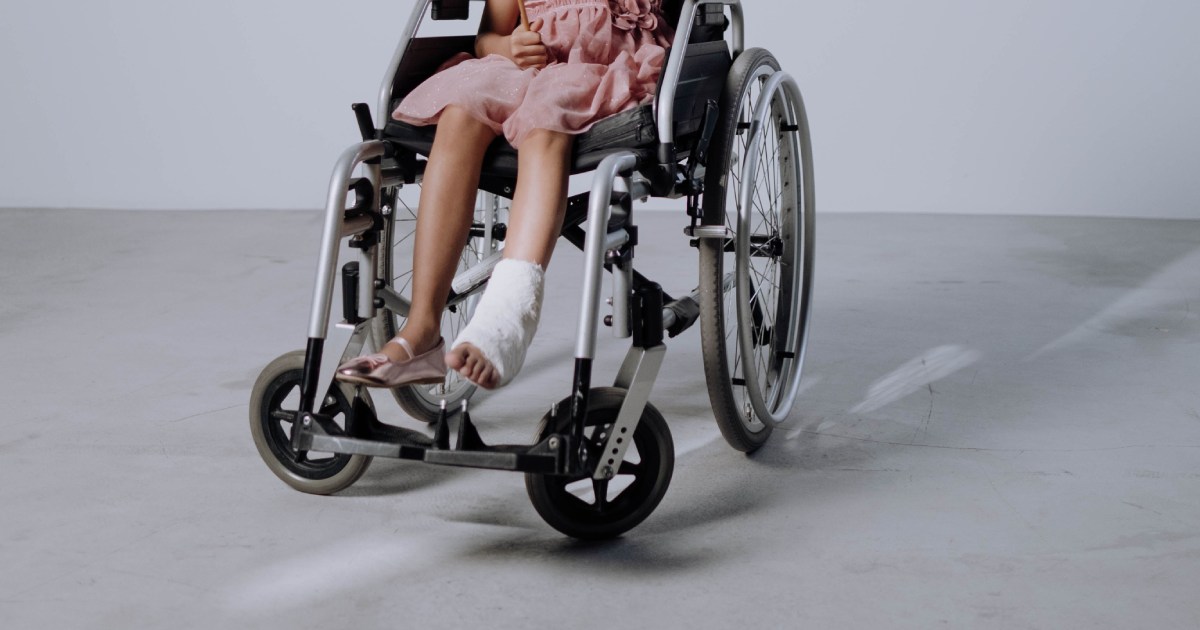The most important facts about “Flying with a plaster-cast”
- Flying with a plaster cast can pose health risks.
- Most airlines offer a wheelchair service.
- You can usually take walking aids with you to the boarding gate.
- However, you must inform the airline of this.
- Flying is strictly prohibited within the first 24 hours after a fracture such as a broken leg.
- Between 24 hours and 48 hours after the fracture, only flights lasting less than two hours are permitted!
- If the plaster cast starts to press during the flight, it should be removed to restore blood circulation.
Did you have a flight delay or cancellation? Check your rights now and increase your chances of compensation
Our comprehensive guide offers tips for a smooth journey so that you can focus on your health. Find out what restrictions you should be aware of, what medication you can take with you and how you can optimize your flight comfort. With our advice, flying with a cast will not only be safe, but also stress-free – making your journey an enjoyable experience, despite potential challenges.
Flying with a plaster cast – Can I fly with a plaster cast?
Can I fly with a plaster cast? Can I fly after an operation? In the first 24 hours after a fracture such as a broken leg, flying is strictly prohibited in order to avoid possible complications due to the initial tissue swelling. This ban even extends to the first 48 hours after the fracture, as this is when the swelling is at its most severe. If a flight is unavoidable, between 24 and 48 hours after the fracture, only flights lasting less than two hours should be considered.
Particular attention should be paid to the first 7 days after the fracture, during which it is recommended to split the cast. This practice can be continued thereafter to allow more space for the tissue, as slight swelling may occur under low air pressure.
It is important to note that airlines may refuse to carry passengers with casts, and the exact regulations can be found in the conditions of carriage. Passengers with casts generally require a medical certificate confirming that they are fit to fly. A visit to the attending doctor not only enables this certificate to be issued, but also provides an opportunity to discuss potential risks. Some airlines also require passengers to sign a declaration of consent to ensure that they are aware of the risks associated with transportation.
Can children with casts fly?
The ability of children with casts to fly depends on various factors, including the type of injury, the stability of the cast and the approval of the treating doctor. The doctor will assess the condition of the injury and make recommendations regarding fitness to fly. The stability of the plaster cast is crucial in order to avoid possible complications.
In addition, airline guidelines must be observed, as some may require additional documentation or measures. The age of the child also plays a role, especially for younger children who may require more care. Before booking a flight, it is advisable to consult with the treating doctor and check the airline guidelines to ensure a safe and comfortable journey.
When can you not fly?
Flying with a plaster cast is not normally permitted in the first few days after a fracture, as the swelling is at its most severe. An unstable cast or prolonged flight may raise further concerns. Changes in air pressure during the flight could be problematic for certain injuries. It is important to check airline guidelines and speak to your doctor before traveling. The doctor can check the cast, assess the condition of the injury and make recommendations for fitness to travel. In some cases, a medical certificate may be required to confirm fitness to fly. Individual circumstances should always be taken into account and the doctor’s instructions should be followed.
How do passengers with a plaster cast get their certificate
To obtain a “fit to fly” certificate for air travel with a plaster cast, air travelers should follow the steps below: First, they contact the doctor or medical professional treating them, be it their GP or a specialist. An appointment will be made to discuss travel plans and evaluate suitability for the flight. During the medical examination, the doctor will check the cast and assess the patient’s state of health to determine their fitness to fly. If the assessment is positive, the doctor will issue the “Fit-to-Fly” certificate, which confirms fitness to fly. It is important to check the airline’s requirements to ensure that all the necessary documents are available in good time before the planned trip.
Are you having trouble with a cancellation or flight delay and don’t want to accept it without doing anything? You shouldn’t either. After all, you are entitled to compensation in many cases of delay or cancellation.
Flight delay compensation, flight cancellation compensation
Compensation for overbooking
Compensation for denied boarding
Order Flightright conveniently online:
We enforce your refund and compensation!
With us, you can check your claims free of charge in two minutes. You can receive up to 600 euros compensation per person (minus the success commission).
When did the airline inform you of the flight cancellation or delay?
On the day of the flight or less than 14 days before or more than 14 days before departure.
Are you also affected by a missed connecting flight? Check your flight now. Simple ✔ fast ✔ & without risk ✔
Do you need an extra seat with a cast?
The need for additional seating for passengers with casts depends on several factors, including the type and position of the cast, individual mobility, and airline policies. For a leg cast, a single seat may be sufficient, while more extensive casts may require additional space. It is important to check the airline’s conditions and consult with your doctor. They can make recommendations regarding comfort and safety during the flight. Before booking, it is advisable to clarify individual needs to ensure an appropriate and comfortable flight and to avoid having to pay for an extra seat.
Are there additional costs when flying with a cast?
Additional costs may be incurred when flying with a cast if an additional seat is required or if special medical documentation, such as a “fit-to-fly” certificate, is needed. The exact costs depend on the airline and individual circumstances. It is advisable to check the airline’s policy and clarify in advance whether additional costs may apply.
How do I book the additional seats I need on the plane?
To book additional seats, you can contact the airline directly. Call their website or customer service phone and explain that you need additional seats. Ask about availability and fees. Alternatively, you can log in to the airline’s online booking system, find the ‘Manage booking’ section, and follow the instructions to add or change seats.
If you have booked through a travel agent, let them know your requirements and they can help you book the additional seats. Note that the exact steps may vary depending on the airline, so it is advisable to check the specific instructions on the website or contact customer service directly.
What are the risks of flying with a plaster cast?
What are the health risks of flying with a cast? Flying with a cast can pose health risks, as the pressure during the flight can cause swelling and discomfort in the cast area.
The restricted freedom of movement and possible circulatory problems increase the risk of discomfort. Medical advice should therefore be sought before the flight to ensure safety. A doctor can assess whether special measures are required and whether flying is safe in your case.
Traveling with a cast – precautions before the flight
If you are traveling with a cast, it is important to take a few precautions before the flight to minimize potential health risks. Start by seeking medical advice from your doctor. Have them check whether it is safe to fly in your case and discuss possible adjustments to the cast to prevent swelling and discomfort during the flight.
During the flight, you should regularly perform light movement and stretching exercises to promote blood circulation. When choosing a seat, give preference to seats with sufficient legroom, ideally an aisle seat for more freedom of movement. Together with your doctor, consider whether it makes sense to take mild painkillers or anti-inflammatory medication to alleviate any discomfort.
Don’t forget to inform your flight insurance company about the cast to ensure that you are adequately covered in the event of complications. By taking these preventative measures, you can minimize the potential risks of holidaying with a cast and make your flight as comfortable as possible.
Flying with a plaster cast – handling a wheelchair
What requirements must my wheelchair or mobility scooter meet to be transported on a flight? To fly with a wheelchair or mobility scooter, inform the airline in advance, reserve the required space, check the batteries, observe weight and size restrictions, secure and pack the device properly, clarify any documentation requirements, and allow sufficient time for check-in at the airport. Also, inform the flight crew of any special requirements on arrival.
Flying with a plaster cast – handling walking aids
When flying with a plaster cast and walking aids, it is important to inform the airline in advance. Reserve the required space for the walking aids and clarify the airline’s specific guidelines. Allow extra time for check-in and inform the flight staff of your situation to ensure a smooth process.
Conclusion on flying with plaster
Flying with a plaster cast requires some precautions. Before traveling, you should obtain a “fit-to-fly” certificate from your doctor in good time. The airline should be informed about the cast and any adjustments to the cast may be necessary. It is advisable to find out about the airlines’ specific guidelines in advance to ensure a smooth process and a relaxed vacation.
How can Flightright help you?
Are you stuck at the airport due to a flight delay? Your flight has been canceled or you have been removed from the passenger list (denied boarding)?
In each of the situations described, you as a passenger have a right to compensation.
According to the EU Passenger Rights Regulation, passengers are entitled to compensation in the event of a delay, cancellation, overbooking, or missed connection. You can claim up to 600 euros of compensation per person (minus commission fee). This compensation is independent of the ticket price. Flightright enforces your right for you. If necessary also in court.
Tip: Flightright helps you to enforce your passenger rights! With us, you can check your claims free of charge in two minutes. ✔️Easy, ✔️fast ✔️& without risk
As the market-leading consumer portal, Flightright fights for the enforcement of air passenger rights. We stand up for your rights in the event of a flight delay, cancellation or denied boarding and refer to the European Union’s Air Passenger Rights Regulation 261/2004. Flightright’s air passenger rights experts are also happy to help you with ticket refunds and refunds for canceled package tours.
As experts in the field of air passenger rights, we enforce your right to compensation against the airline!

